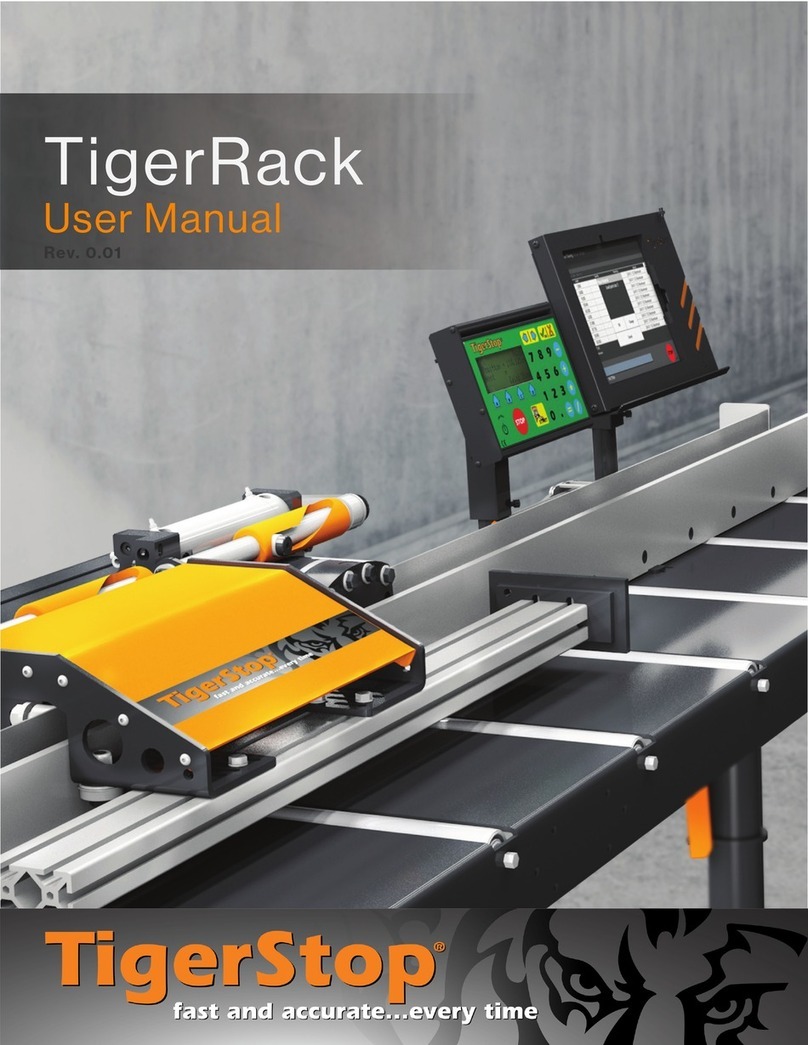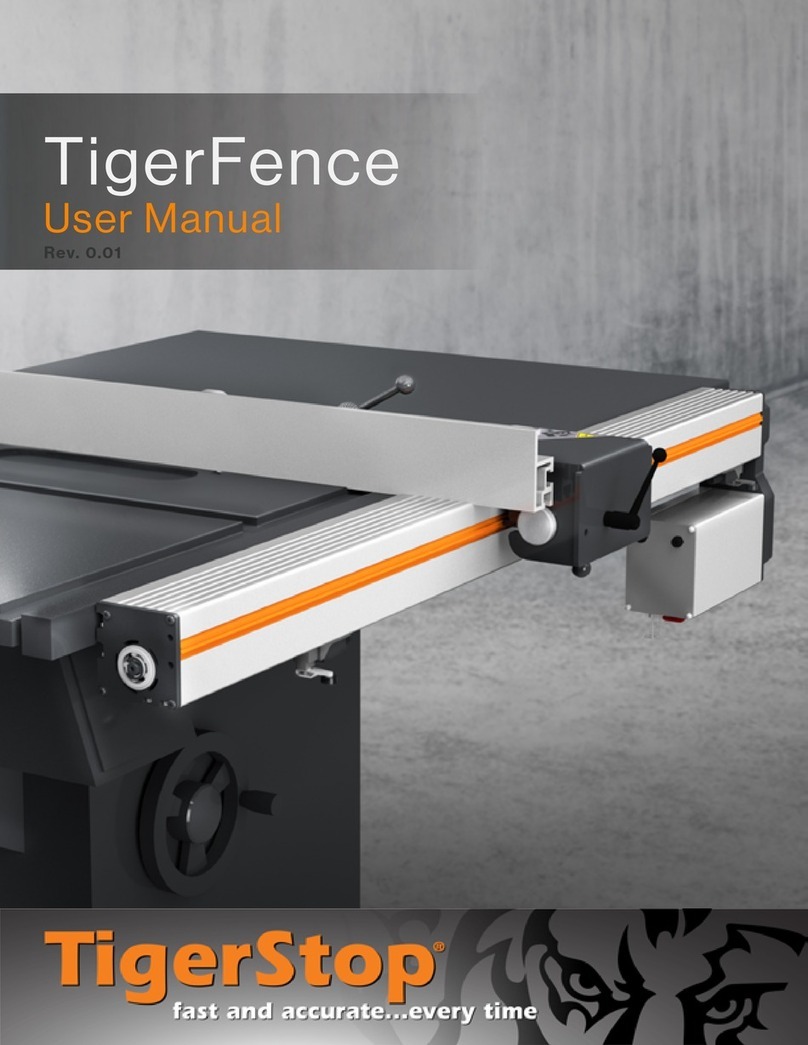TigerStop TigerSaw 1000 User manual

TigerSaw 1000
User Manual
Rev. 0.2


iii
Table of Contents
1 Contact Us
2 System Requirements
2 Power
2 Air SuPPly
2 DuSt extrAction
3 TigerSaw 1000 Overview
4 Safety Chain
4 Kill Switch
5 SAfety interlocKS
6 Systems & Features
6 DoorS
6 Air
7 clAmP
8 i/o PAnel
8 AmPlifier
9 Controls
9 mAnuAl controlS
11 PneumAtic controlS
12 AutomAteD controlS
12 oPerAting moDe
13 StArt-uPProceDure
14 Basic TigerStop®Standard
Controller Operation
14 home routine
14 reADy Screen
15 mAnuAl movement
15 cAlculAtor moDe
16 increment
17 PreSet
18 Jog
19 QuicK cAlibrAtion
20 The TigerStop®Standard
Controller Menus
20 menu Selection
21 cAlibrAte
21 Kerf
21 unitS
22 finD enD limitS
22 minimum limit
23 DiSAble QuicK cAlibrAtion
23 PASSworD
23 Jog reverSe
24 PreSet behAvior
24 SAw onDelAy
24 clAmP off DelAy
25 TigerTouch
25 StArtuP
26 move Screen
27 liSt Screen
28 oPtionS Screen
29 Troubleshooting
29 movement AnD AccurAcy
29 “not SAfe” wArning
29 x-out
30 boot DiAgnoSticS
31 i/o teSt
31 SAw StroKe AnD cut QuAlity
32 toP Arbor SenSor
33 cleAring AJAm
34 Maintenance
34 cleAnlineSS
34 PreventAtive mAintenAnce ScheDule
35 fixeD guArD removAl
35 rePlAcing the SAw belt
36 tenSioning the belt
36 chAnging the chiP breAKer
37 run the Drive teSt
38 Air SyStem
38 Direction of blADe rotAtion
39 cutting enveloPe
40 SQuAring the blADe
41 chAnging the SAw blADe
43 Maintenance Log

iv
Table of Contents
44 Appendix A: Replacement Parts
44 SAw SyStem PArtS
45 PoSitioner PArtS
47 Appendix B: Scale
48 Appendix C: Inkjet Printer
48 Printer tyPe
48 Print cut
48 inKJet offSet
49 Printer height ADJuStment
49 Printer cArtriDge rePlAcement
49 cleAning the Printer cArtriDge
50 Appendix D: Clamping Add-ons
50 SPring clAmPS
50 Double clAmPS
50 Swing clAmP
51 clAmP SettingS
53 Appendix E: Scanning Defecting Pusher Foot
53 ScAnning Defecting PuSher foot overview
53 enAble/DiSAble crAyon Defecting
53 tigertouch: running AliSt with Defecting
54 tigertouch: grADe mArKing liStS
55 Defect only moDe
56 ScAnning Defecting PuSher foot SettingS
57 Air flow ADJuStment
57 PuSher foot height AnD level ADJuStment
58 fS SenSor focuS cAlibrAtion
58 fS SenSor SenSitivity ADJuStment
59 fS SenSor StocK reference ADDition
59 eDge Detect SenSor SenSitivity ADJuStment
60 ADDitionAl ScAnning Defecting PuSher foot SettingS

v
SAFETY FIRST!
IMPORTANT SAFETY INFORMATION. READ ALL WARNINGS BEFORE OPERATING THIS PRODUCT.
WARNING: Installation of your TigerStop® Product must be done by a person trained in the safe design and installation of
automation products, and in the safe operation of power equipment. Ensure that such installation meets all legally required
safety requirements and guidelines, and that proper guarding and safety devices are provided on all sides of the equipment to
preclude unintended access during operation. Consult with and follow the recommendations of a qualified safety engineer.
WARNING: TigerStop® Products are components intended for use in conjunction with potentially dangerous machinery.
The use of TigerStop® Products does not make other machinery safe. TigerStop® Products are not intended to substitute,
in any manner, for safe operating practices in general, or for safety features present in other machines designed to make
those machines as safe as possible. TIGERSTOP® PRODUCTS, IF USED OR INSTALLED IMPROPERLY, MAY CAUSE
PERSONAL INJURY OR DEATH AND SHOULD ONLY BE OPERATED BY PERSONS TRAINED IN THEIR SAFE OPERATING
PROCEDURES. Illustrations of TigerStop® Products in use do not show, and are not intended to show, all safety features and
practices necessary for their safe operation.
WARNING: TigerStop® Products must be installed in accordance with all local, state, and federal regulations. Only personnel
properly trained in the safe design and installation of automation machinery and related power equipment should install
TigerStop® Products onto other equipment, to ensure a safe and proper work station. TigerStop® Products should not be
operated without proper training, both in the operation of TigerStop® Products, and in the operation of related equipment.
IMPORTANT CAUTION:
The motor box (compartment) contains DC voltage with potentially FATAL amperage. NEVER attempt any unauthorized actions
inside the motor box.
WARNING: Using a TigerStop® interconnect does not relieve you of the responsibility for making sure that your saw or other
tool has all the necessary safety equipment in place. All installations must meet all legally required safety requirements and
guidelines. Installation and training should be done following the recommendations of a qualified safety engineer.
DANGER: This machine can start, move and stop automatically. Keep hands and loose clothing clear of moving parts while
operating. Moving parts can crush and cut. When used with a saw or other cutting equipment, bodily injury and death may result
if operated without safety guards on all machines. Do not operate with guards removed. Operators must wear adequate eye and
ear protection.
GENERAL WARNINGS
INSTALLATION WARNINGS
INTERCONNECTS
OPERATION

vi
IMPORTANT SAFETY INFORMATION. READ ALL WARNINGS BEFORE OPERATING THIS PRODUCT.
DANGER! Don’t get pinched by the push feeder. Keep your hands away when in motion!
Keep the work area clean and well lighted to avoid accidental injury.
Do not operate near flammable liquids or in gaseous or explosive atmospheres!
Use only 3-wire extension cords that have 3-prong grounding type plugs and 3-pole
receptacles that accept the tools plug for 120VAC. Use only 5-wire cords and plugs
when using 3 phase.
Do not open motor compartment or controller keypad. DC Voltage with potentially
FATAL amperage! Disconnect power before servicing. No user-serviceable parts inside.
DO NOT operate this or any machine under the influence of drugs or alcohol!
No one should operate this machine except for fully qualified personnel.
READ THE MANUAL!
Do not use TigerStop® machines in a dangerous environment. Using power tools in damp
or wet locations or in rain can cause shock or electrocution.
Wear proper apparel, no loose clothes, long hair or jewelry which could get pulled into
moving machinery or materials. Wear non slip footwear, safety glasses, ear protection
and a dust mask.

vii
Please follow these basic safety guidelines. This list is in no way complete as every environment and shop is
dierent.
1. Always treat TigerSaw and all power tools with caution and respect. Failure to do so risks serious personal injury
or death.
• Always attend to a running TigerSaw.
• Always keep hands away from the cutting area while TigerSaw is running. Use a push stick or similar safety
appliance to remove or reposition material in the cutting area, if necessary.
• Always wear proper work apparel when operating TigerSaw. No loose clothing, long-sleeved shirts, rings, or
other jewelry as these could get caught in moving parts. Tie back hair that is longer than shoulder length.
• Operate TigerSaw with proper training, only.
• Always read the operation manual before attempting to install or use TigerSaw.
2. Always keep the work area clean and organized, clear of dust and debris, and free of objects that could cause
damage to the machine or personal injury.
• Place the machine on a floor that is level, well-maintained, and free of loose material (including chips and
o-cuts).
• Clean dust and debris o the saw/tables by using forced air or a shop brush, only.
• Remove chips and dust regularly to avoid the risk of fire.
• Place stock and finished work close to the operator’s normal working position.
3. Follow the blade manufacturer’s instructions for use, adjustment, and repair of saw blades.
• Always observe the maximum speed marked on the blade.
• Always use correctly sharpened saw blades.
• Use the flanges (collars) supplied with the TigerSaw, only. Ensure that they are free of wear and foreign
particles whenever changing or inspecting the blade.
4. Exercise caution when performing machine maintenance.
• Follow instructions for maintenance and lubrication.
• Immediately report faults in the machine, including guards and blades.
• Ensure that guards and other safety devices are in place, in good working order, and well maintained.
• Never disable or bypass safety circuitry.
• Always isolate TigerSaw from power and follow proper lock out/tag out procedures before making
adjustments or performing maintenance. Verify that all guards and safety devices are in working order
before returning TigerSaw to service.
• Ensure clamps are working properly.
5. Wear suitable personal protective equipment.
• Always wear safety glasses when nearby the TigerSaw to reduce the risk of injury from flying debris.
• Always wear ear protection when nearby the TigerSaw to reduce the risk of induced hearing loss.
• Always wear cut-resistant gloves when handling saw blades. Carry blades in a holder whenever possible.
• Always wear steel-toed footwear when processing heavy or large stock.
• Wear respiratory protection if the stock being processed produces harmful dust.
Safety & Ergonomics
Basic Safety Guidelines

viii
Posture
Human error and behavior
Maintaining a neutral posture whenever possible reduces the risk for musculoskeletal disorders and repetitive strain
injuries.
In a neutral posture:
• Feet rest comfortably on the floor, one foot slightly forward. Use anti-fatigue floor mats or shoes, where
possible.
• Knees are slightly bent.
• Head, neck, and shoulders are vertically aligned above the hips.
• Upper arms are at rest against the torso.
• Elbows are bent approximately 90 degrees.
• Wrists are straight and flat so that hands are in-line with forearms.
It is easiest to maintain a neutral posture for tasks at heights between mid-thigh and mid-chest. This is an important
consideration for material staging and transport.
Frequent changes in posture and range of motion are another way to reduce risk for musculoskeletal disorders
and repetitive strain injuries.
• Breaks are important; shorter but more frequent breaks are best.
• Stretching, sitting, and/or lying down during breaks is encouraged.
• Rotating workers through multiple tasks helps maintain productivity while promoting variety in posture and
movements.
Avoid encouraging risky behavior when measuring productivity.
Eliminating distractions and providing checklists for complex tasks helps reduce the frequency of unconscious
errors.
Reduced time pressure, adequate training, and written procedures/diagrams helps reduce the frequency of
decision-making errors.
Adequate supervision, realistic requirements, sucient resources, and open communication with workers helps
reduce the frequency of deliberate violations.
Safety & Ergonomics
Noise
The noise associated with circular sawing is proportional to energy wasted in the cutting action. Prolonged exposure
to noise at or above 85 dB is hazardous.
There are three primary ways to minimize blade noise:
1. Use blades designed to reduce noise. Considerations include the gullet geometry, tooth profile, and the material
used in the teeth.
2. Adjust the stroke speed. Cutting faster typically means more wasted energy and cutting too fast can clog gullets.
Determine the appropriate stroke speed by accounting for material, tooth angle and size, cut depth, gullet size,
and the speed of the tooth at contact.
3. Maintenance. A well-sharpened blade is critical to saw performance. Ensure that the blade assembly is
completely free from defects and debris and is secure at all times.

1
Contact Us
12909 NE 95th Street
Vancouver, WA 98682-2426
TigerStop Global Headquarters
Phone: +1 (360) 448 6102
TigerStop Customer Service
Email: service@tigerstop.com
TigerStop Customer Service
Bedrijvenstraat 17 NL-7641 AM
Wierden, Netherlands
TigerStop Europe
TigerStop Sales
Phone: +1 (360) 254 0661 ext 2
TigerStop Sales
Email: sales@tigerstop.com
TigerStop Headquarters
Phone: +1 (360) 254 0661
Fax: +1 (360) 260 0755
TigerStop Headquarters
Email: careers@tigerstop.com
TigerStop Europe
Phone: +31 546 575 171
TigerStop Mexico
Phone: +1 (360) 254 0661
Follow Us
Oces Call Us Email Us
TigerStop Europe | Sales
Phone: +31 546 575 171 (option 2)
TigerStop Europe | Service
Phone: +31 546 575 171 (option 1)
TigerStop Europe
Email: info@tigerstop.nl
TigerStop Europe | Sales
Email: info@tigerstop.nl
TigerStop Europe | Service
Email: sos@tigerstop.nl

2
System Requirements
Power
VOLTS FULLLOAD AMPS CIRCUIT BREAKER
208/230/240V 3Ph 26.5A 30A
400/460/480V 3Ph 17A 20A
• The TigerSaw 1000 requires a dedicated, grounded circuit.
• Balance voltages between phases, from each phase to ground, and within +/-10% of system requirements.
• 208/230/240V saw systems: Line-to-line voltage must not exceed 240V. Line-to-neutral voltage must not
exceed 140V.
• 400/460/480V saw systems: Line-to-line voltage must not exceed 500V. Line-to-neutral voltage must not
exceed 300V.
Operating TigerSaw 1000 without proper grounding risks electrocution.
Minimum Air Pressure 80 psi (550 kPa)
Maximum Air Pressure 110 psi (758 kPa)
Air Supply
Mouth Diameter 4 in (102mm)
Dust Extraction
There are 3 dust extraction ports on the rear of the
machine. 1 primary port near the base and 2 auxiliary
ports near the top.

3
TigerSaw 1000 Overview
Guard Door TigerTouch
Saw Control Panel
Air Gun
Emergency Stop
Pneumatic Control Panel
Blade Access Door
Kill Line
I/O Cabinet
Cycle Start Button

4
Safety Chain
Kill Switch
In an emergency, there are two ways to kill power:
1. Push the E-stop button.
2. Pull the kill line.
Triggering any kill switch signals a relay to cut power to the positioner and the blade. You cannot power the
system until the kill switches reset.
Emergency Stop
The emergency stop (E-stop) is located on the saw control panel.
Pressing the E-stop immediately halts the saw motor, retracts the blade,
and raises the top cap.
Rotate the E-stop clockwise to reset.
Kill Line
The kill line is a red cable stretching the entire length of the saw system.
Pulling the kill line triggers an emergency stop.
Pull the blue knob under the kill line switch until it clicks to reset.
If the blue knob won’t lock into place, adjust the kill line tension (page 5).

5
Safety Chain
Kill Line Tension
If the blue button on the kill line switch won’t
lock into place, adjust the kill line tension with
the tension plate eye bolt.
At proper tension, the black tab sits near the
center of its green band and the blue knob locks
into place; exposing its own green band.
Safety Interlocks
• There are 2 access doors on the TigerSaw
1000.
• Each access door has a separate safety
interlock.
• The safety interlock on the blade access
door prevents access to the saw cabinet until
someone triggers an emergency stop.
• The guard door safety interlock releases
after a delay when the saw motor turns o.
• The saw motor will not activate while a safety
interlock is open.
The blade continues spinning after the
motor stops.
DO NOT disable or bypass the safety interlocks.
Replace failed safety interlocks immediately.

6
Systems & Features
Doors
Guard Door
The guard door allows access to the work area
for adjusting material and cleaning.
Blade Access Door
The blade access door is for maintenance, only.
It comes equipped with the tools necessary to
change the saw blade.
I/O Cabinet
The I/O Cabinet houses the I/O Panel as well as
the Saw Blade and Top Cap solenoids.
Air
Adjust air pressure in the TigerSaw 1000 with the Supply Regulator.
• Normal supply pressure is 80-110 psi (550-758 kPa).
1. Lift the gray knob to unlock adjustment.
2. Turn the knob clockwise to increase the pressure or
counterclockwise to decrease it.
3. Wait for the pressure to adjust.
4. Push the knob down to lock the setting.
Rotate the black knob to turn air on/o to the saw system.

7
Systems & Features
Air Gun
Use the Air Gun to clean excess debris from the cabinet.
Clamp
The TigerSaw 1000 comes standard with a Top Cap.
Top Cap
The Top Cap is an overhead clamp that pins the stock to the
table during the saw stroke.
Top Cap Working Height
Set the Top Cap working height with the height adjustment
wheel.
Adjust the top cap working height:
1. Disconnect power and air.
2. Turn the height adjustment wheel.
3. Reconnect power and air and check the new height.
Ideal top cap working height allows for 1 inch
(25 mm) of clearance for the tallest material.

8
Systems & Features
I/O Panel
The I/O Panel serves as the communication hub for the saw
system, its accessories, and the positioner.
Amplifier
The Amplifier drives the positioner’s motor. Toggle the red
switch to power on/o the positioner.

9
Controls
Manual Controls
System Power
The main power is controlled with the rotary switch on the saw control panel. In the ‘OFF’ position, the switch
pops out for lockout/tagout.
Power Switches
Saw Switch:
The START button activates the saw motor.
The STOP button turns the saw motor o.
The blade continues spinning after the motor stops.
TigerStop®Switch:
The START button activates the TigerStop®Standard Controller.
The STOP button deactivates the TigerStop®Standard Controller.
Indicator Lights
Power: Glows when the system is electrified.
Saw: Glows when the saw motor is active.
Air: Glows when the air pressure is good.
Safety Chain: Glows when the kill switches are ready.

10
Controls
Saw Cycle
To start a manual saw cycle, press the Cycle Start button.
During a saw cycle:
• The top cap lowers.
• The saw strokes and returns to the base.
• The top cap rises.
The positioner cannot move during saw cycles.
A saw cycle can also start within an automated list in the
TigerTouch software (page 25).
Solenoids
The left solenoid controls the Saw Blade and the right controls
the Top Cap. Press the blue tear-drop button to activate the
Saw Blade or Top Cap and turn the button to the right to lock it
in place.
Saw Blade Top Cap

11
Pneumatic Controls
Stroke Speed
Stroke speed aects cut quality and cycle time. Directly control the saw stroke speed
with the ‘Stroke Speed’ knob.
Turn the knob clockwise to decrease the stroke speed. Turn the knob counterclockwise
to increase the stroke speed.
• Ideal stroke speed is as fast as possible while still achieving desired cut quality.
• Cycle time should not change when material is being cut.
Top Clamp
Top clamp controls how fast the Top Cap descends.
Turn the knob clockwise to decrease Top Cap descent speed. Turn the knob
counterclockwise to increase Top Cap descent speed.
Clamp Pressure
Reduce clamp pressure to lower the force of the Top Cap’s descent.
• Clamp pressure does not aect speed.
• Clamp pressure cannot exceed the Supply Regulator’s pressure.
Infeed Clamp (Requires double clamps or Swing Clamp)
Decrease infeed clamp to reduce the force of the infeed clamp or Swing Clamp.
• Infeed clamp does not aect speed.
• Infeed clamp cannot exceed the Supply Regulator’s pressure.
Outfeed Clamp (Requires double clamps)
Decrease outfeed clamp to reduce the force of the outfeed clamp.
• Outfeed clamp does not aect speed.
• Outfeed clamp cannot exceed the Supply Regulator’s pressure.
Controls

12
Controls
Automated Controls
TigerTouch
The TigerTouch tablet is the primary human-machine
interface. For basic operation, see page 28.
The TigerTouch power button is on the top-left edge of
the tablet.
TigerStop®Standard Controller
The TigerStop®Standard Controller is for direct control of
the positioner. For basic operation, see page 14.
Operating Mode
TigerSaw 1000 is a fully automatic saw system.
Full Auto: Both cutting and positioning are automated.
• TigerSaw 1000’s standard setting.
• The operator selects a part list, loads stock, and starts the process.
• The system automatically pushes and cuts until the stock is processed.
• The operator loads the next stock.
Other manuals for TigerSaw 1000
1
This manual suits for next models
1
Table of contents
Other TigerStop Industrial Equipment manuals
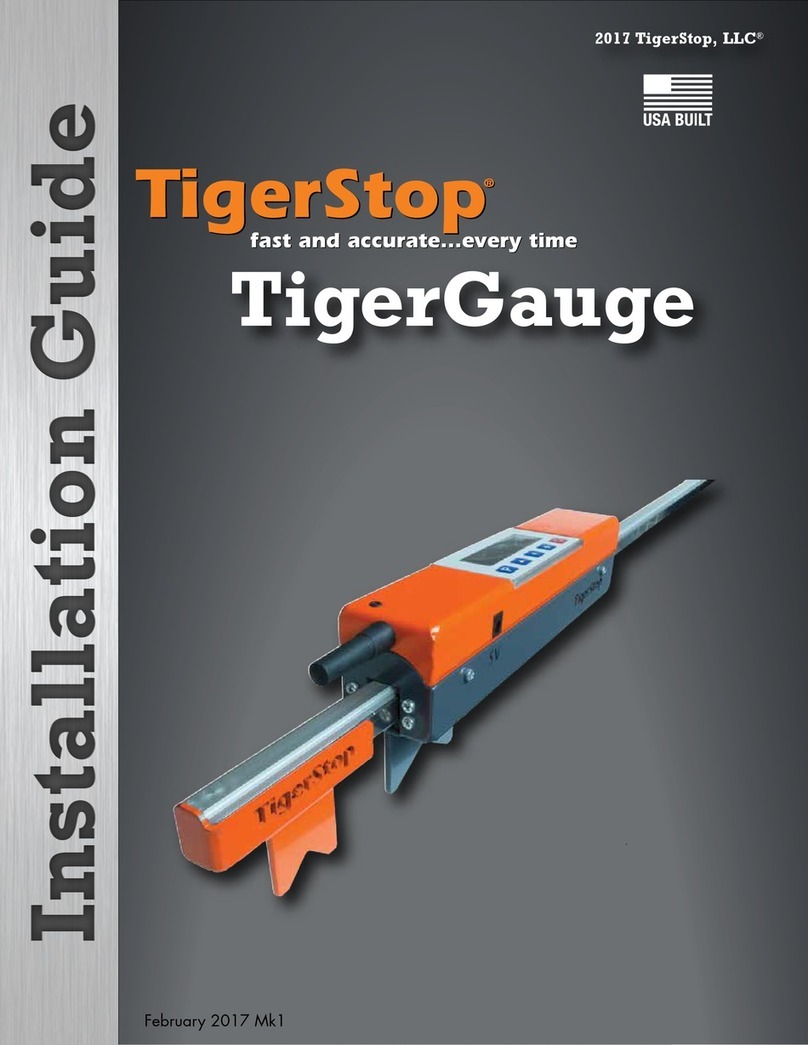
TigerStop
TigerStop TigerGauge User manual
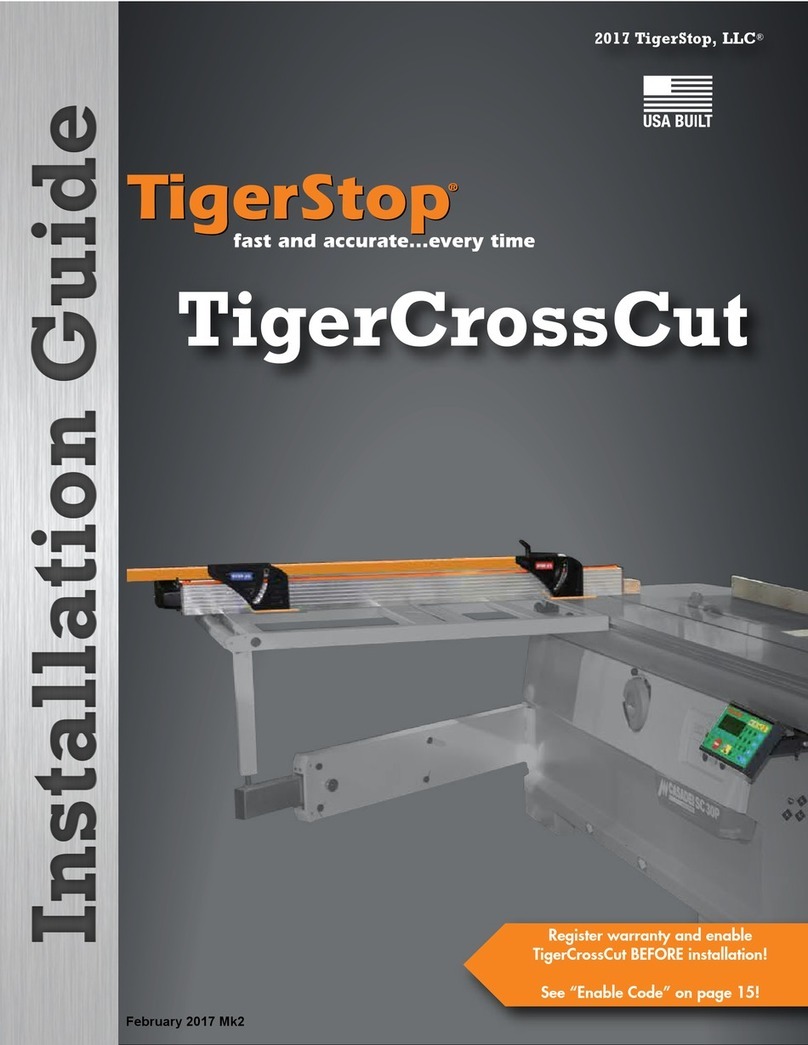
TigerStop
TigerStop TigerCrossCut User manual

TigerStop
TigerStop TigerScan User manual

TigerStop
TigerStop TigerSPC User manual

TigerStop
TigerStop TigerSaw 1000 User manual
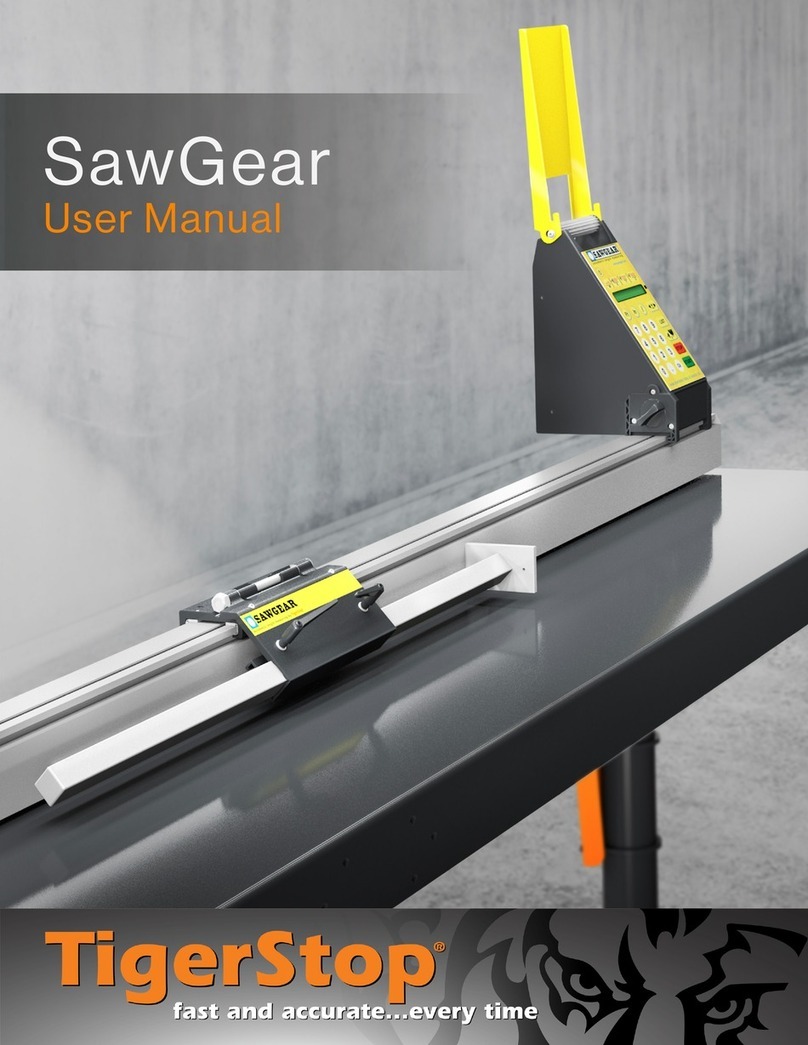
TigerStop
TigerStop SAWGEAR User manual
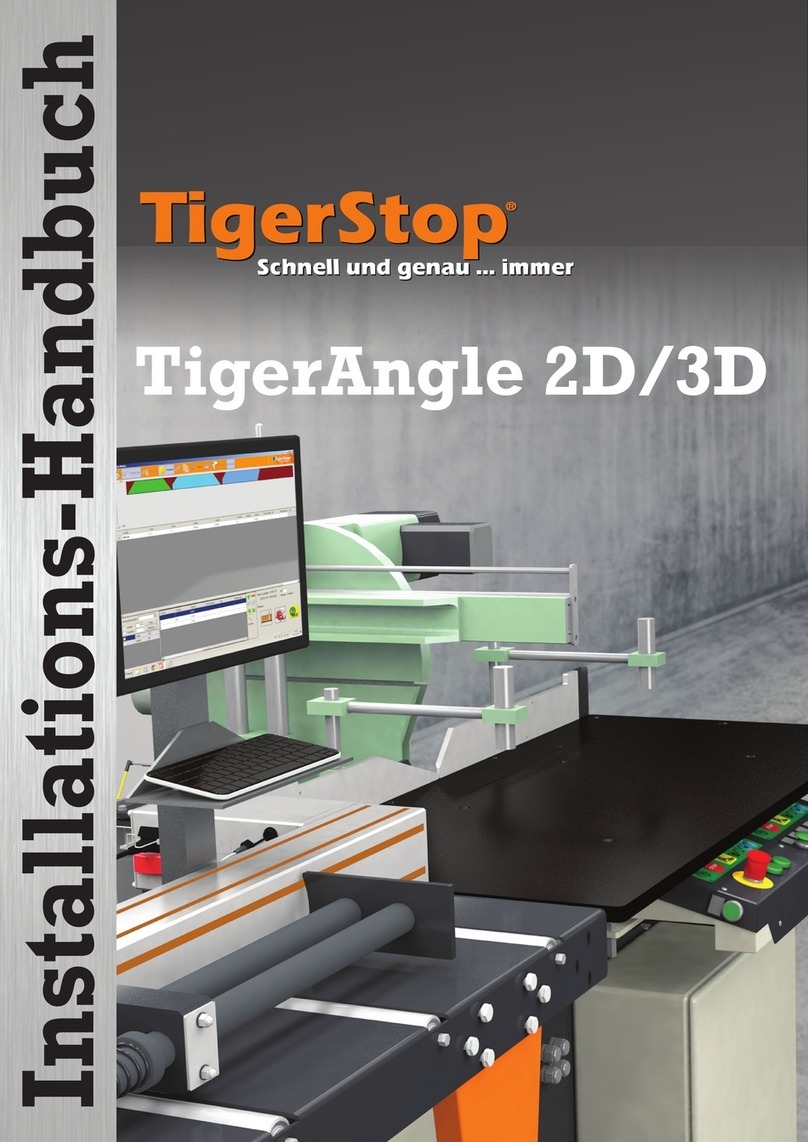
TigerStop
TigerStop TigerAngle 2D System manual
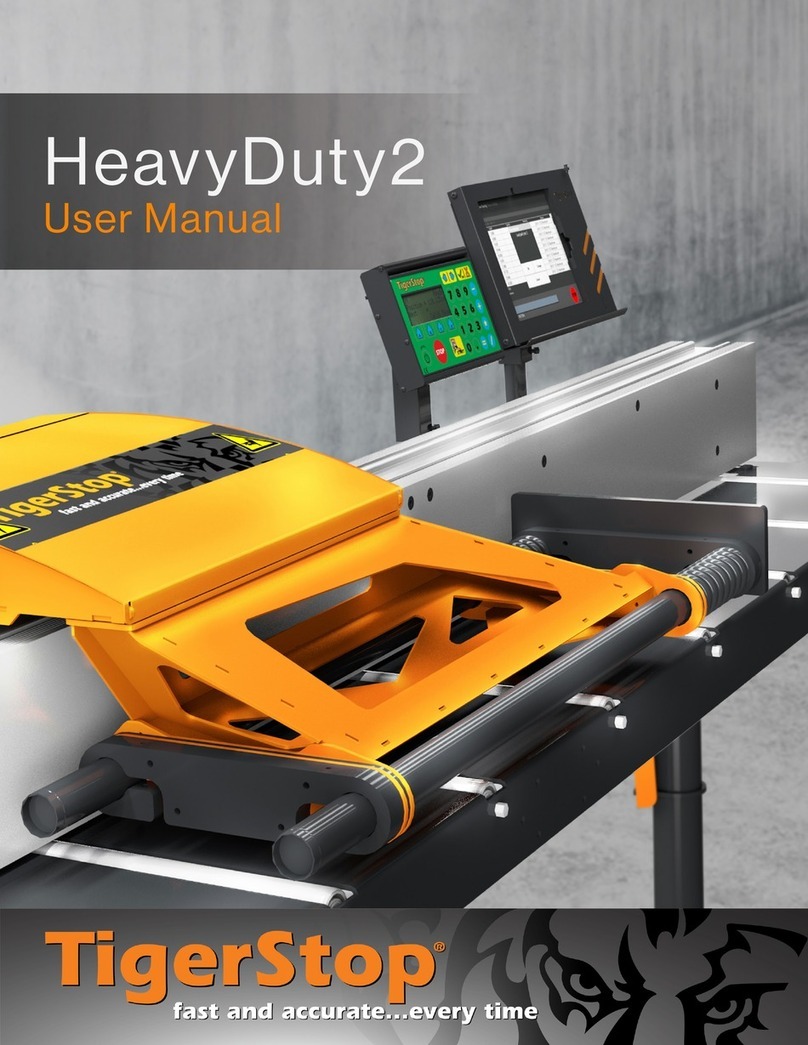
TigerStop
TigerStop HeavyDuty2 User manual
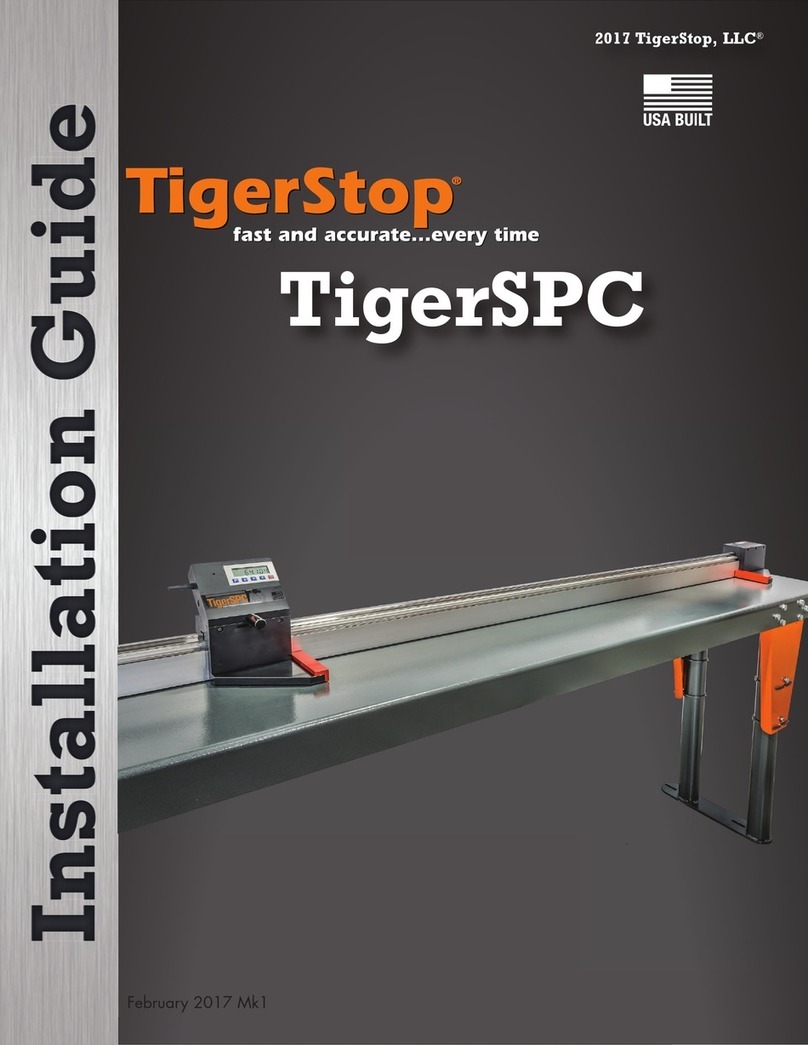
TigerStop
TigerStop TigerSPC User manual
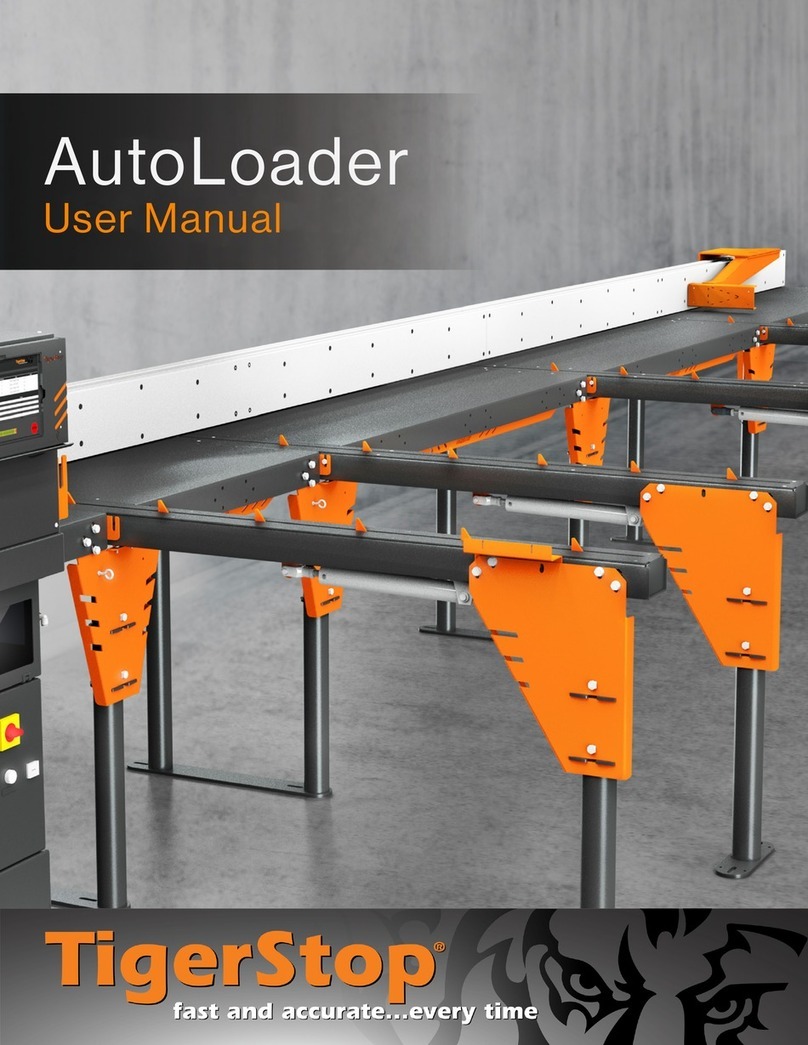
TigerStop
TigerStop AutoLoader User manual
